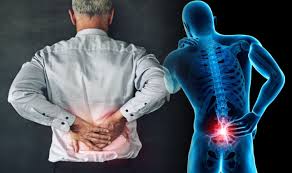
Low back pain is a common condition that affects millions of people worldwide. While there are various causes of low back pain, one of the most common is vertebrogenic low back pain. This type of pain is caused by problems in the spinal column, including the vertebrae, discs, and nerves. In this article, we will discuss the causes, symptoms, and treatment options for vertebrogenic low back pain.
Causes of Vertebrogenic Low Back Pain
Vertebrogenic low back pain can be caused by various factors, including:
1. Disc Herniation: Disc herniation occurs when the soft inner material of a spinal disc protrudes through a tear in the outer layer. This can cause pressure on the nerves in the spinal column, leading to pain.
2. Spinal Stenosis: Spinal stenosis is a condition where the spinal canal narrows, putting pressure on the spinal cord and nerves. This can cause pain, numbness, and weakness in the legs.
3. Spondylolisthesis: Spondylolisthesis is a condition where one vertebra slips forward over another. This can cause pressure on the nerves in the spinal column, leading to pain.
4. Degenerative Disc Disease: Degenerative disc disease is a condition where the discs in the spinal column degenerate over time. This can cause pressure on the nerves in the spinal column, leading to pain.
Symptoms of Vertebrogenic Low Back Pain
The symptoms of vertebrogenic low back pain can vary depending on the underlying cause. Some common symptoms include:
1. Pain: The most common symptom of vertebrogenic low back pain is pain in the lower back. The pain can be dull or sharp and may radiate to the buttocks, legs, or feet.
2. Numbness or Tingling: Some people with vertebrogenic low back pain may experience numbness or tingling in the legs or feet.
3. Weakness: Weakness in the legs or feet can also occur in some cases of vertebrogenic low back pain.
4. Difficulty Walking: In severe cases, vertebrogenic low back pain can make it difficult to walk or stand for extended periods.
Treatment Options for Vertebrogenic Low Back Pain
The treatment options for vertebrogenic low back pain depend on the underlying cause and severity of the pain. Some common treatment options include:
1. Physical Therapy: Physical therapy can help improve flexibility, strength, and range of motion in the lower back. This can help reduce pain and prevent future injuries.
2. Medications: Over-the-counter pain medications, such as ibuprofen or acetaminophen, can help reduce pain and inflammation. In some cases, prescription medications may be necessary.
3. Injections: Injections of corticosteroids or numbing medications can help reduce inflammation and pain in the lower back.
4. Surgery: In severe cases, surgery may be necessary to relieve pressure on the nerves in the spinal column. This may involve removing a portion of a herniated disc or fusing two vertebrae together.
Preventing Vertebrogenic Low Back Pain
While it may not be possible to prevent all cases of vertebrogenic low back pain, there are some steps you can take to reduce your risk:
1. Maintain a Healthy Weight: Excess weight can put strain on the lower back, increasing the risk of injury.
2. Exercise Regularly: Regular exercise can help improve flexibility, strength, and range of motion in the lower back, reducing the risk of injury.
3. Practice Good Posture: Good posture can help reduce strain on the lower back, reducing the risk of injury.
4. Lift Objects Properly: When lifting heavy objects, use your legs instead of your back to avoid injury.
Conclusion
Vertebrogenic low back pain is a common condition that can be caused by various factors, including disc herniation, spinal stenosis, spondylolisthesis, and degenerative disc disease. The symptoms of vertebrogenic low back pain can vary but often include pain, numbness or tingling, weakness, and difficulty walking. Treatment options include physical therapy, medications, injections, and surgery. While it may not be possible to prevent all cases of vertebrogenic low back pain, maintaining a healthy weight, exercising regularly, practicing good posture, and lifting objects properly can help reduce your risk. If you are experiencing low back pain, it is important to speak with your healthcare provider to determine the underlying cause and appropriate treatment options.